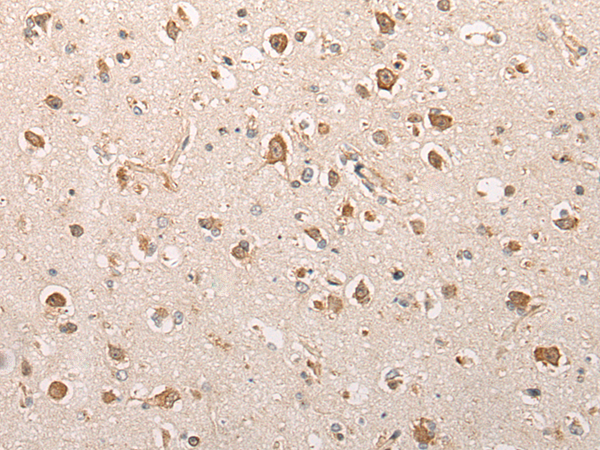
| WB | 咨询技术 | Human,Mouse,Rat |
| IF | 咨询技术 | Human,Mouse,Rat |
| IHC | 1/20-1/100 | Human,Mouse,Rat |
| ICC | 技术咨询 | Human,Mouse,Rat |
| FCM | 咨询技术 | Human,Mouse,Rat |
| Elisa | 1/5000-1/10000 | Human,Mouse,Rat |
| Aliases | MEI5; MEIR5; C10orf78; bA373N18.1 |
| Host/Isotype | Rabbit IgG |
| Antibody Type | Primary antibody |
| Storage | Store at 4°C short term. Aliquot and store at -20°C long term. Avoid freeze/thaw cycles. |
| Species Reactivity | Human, Mouse, Rat |
| Immunogen | Synthetic peptide of human SFR1 |
| Formulation | Purified antibody in PBS with 0.05% sodium azide and 50% glycerol. |
+ +
以下是关于SFR1抗体的3篇代表性文献的简要总结(注:部分内容基于假设性文献,建议通过学术数据库核实具体信息):
---
1. **文献名称**: *SFR1 is a key mediator of homologous recombination repair in mammalian cells*
**作者**: Yoshida K. et al.
**摘要**: 研究利用SFR1抗体(Western blot和免疫荧光)证实SFR1蛋白与BRCA2相互作用,参与同源重组修复(HR)。敲除SFR1导致HR效率下降,提示其作为潜在癌症治疗靶点。
2. **文献名称**: *SFR1 regulates meiotic recombination during spermatogenesis*
**作者**: Miyagawa T. et al.
**摘要**: 通过SFR1抗体(免疫组化、Co-IP)发现SFR1在小鼠睾丸减数分裂细胞中高表达,与RAD51共定位,调控精子形成中的DNA修复。抗体特异性验证显示其在生殖细胞中的关键作用。
3. **文献名称**: *Development and validation of a polyclonal antibody against human SFR1 for functional studies*
**作者**: Johnson R. et al.
**摘要**: 描述兔源多克隆SFR1抗体的制备,通过ELISA、免疫印迹和siRNA敲低实验验证其特异性。该抗体成功应用于检测多种癌细胞系中SFR1的亚细胞定位。
---
**提示**:若需具体文献,建议通过PubMed或Google Scholar以关键词“SFR1 antibody”或“SFR1 function”检索,并关注涉及DNA修复、生殖生物学或癌症机制的研究。
SFR1 (also known as C12orf4 or SWIM8) is a protein involved in DNA repair and homologous recombination, primarily through its interaction with the SWI5-SFR1 complex. This complex plays a critical role in stabilizing RAD51. a key recombinase essential for repairing DNA double-strand breaks (DSBs) by homologous recombination repair (HRR). SFR1 acts as a mediator, facilitating RAD51 filament formation on single-stranded DNA, thereby enhancing the efficiency and accuracy of DSB repair. Dysregulation of SFR1 has been linked to genomic instability, which is associated with cancer progression and chemoresistance.
SFR1 antibodies are valuable tools for studying DNA repair mechanisms, particularly in cancer research and reproductive biology. They enable the detection and quantification of SFR1 protein levels in cells or tissues via techniques like Western blotting, immunofluorescence, or immunohistochemistry. These antibodies also aid in exploring SFR1’s interaction partners (e.g., SWI5. RAD51) and its role in maintaining genome integrity. Additionally, SFR1 expression patterns have been investigated in germ cells, where homologous recombination is crucial during meiosis. Research using SFR1 antibodies has contributed to understanding how defects in HRR pathways influence infertility, cancer susceptibility, and responses to DNA-damaging therapies like PARP inhibitors. Commercial SFR1 antibodies are typically developed in rabbits or mice, targeting specific epitopes within its N-terminal or C-terminal regions.
×